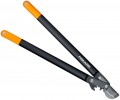Max. cutting diameter
The largest diameter (thickness) of a branch that the tool can handle.
The larger the maximum cut diameter, the more powerful this model, the lower the likelihood that a certain branch will be too tough for the tool. At the same time, note that to ensure high power, long handles and strong blades are needed, which accordingly affects the dimensions, weight and price. Therefore, it is worth choosing according to this parameter with a certain margin, but at the same time, this margin should not be too large.
As for specific figures, a maximum diameter
of 20 mm or less is considered relatively small, but it often turns out to be quite enough for simple work.
21 – 30 mm — the average value,
31 – 40 mm — above average, and in loppers the maximum thickness can
exceed 40 mm.
Handle adjustment
The ability
to adjust the length of the handles or the width of their disclosure on the tool, adjusting it to certain situations.
Longer handles at least allow you to reach further and achieve more force on the blade (due to the large length of the lever); shorter ones, in turn, make the tool more compact and manoeuvrable. In these moments, the meaning of this adjustment lies: in cramped conditions, the handles can be shortened, reducing the length of the tool to a minimum, and if there is enough space, lengthen in order to reduce the cutting force and at the same time increase its efficiency.
Note that in some models, in addition to the length, the distance between the handles can also be adjusted — to adjust to the personal characteristics of the user. This point should be clarified separately.
Handle material
The material from which the additional overlays for the tool handle are made. Most often, this material differs from the material of the handle itself (see above), but there are exceptions — for example, additional plastic lining on the plastic handle. Anyway, the most popular types of materials are as follows:
— Rubber. Convenient, practical and inexpensive, and therefore — an extremely popular material. Secure to hold and at the same time relatively soft, making it great for both plastic and metal handles: rubber grips do not slip in the hand, do not cool the skin in cool weather and provide additional comfort due to the softness. The disadvantages of rubber include poor scratch resistance and a slightly higher cost than another popular option — plastic. However, in general, these shortcomings cannot be called critical.
— Plastic. Another fairly popular material, widely used primarily with steel and aluminium handles. Plastic provides a secure hold, it does not slip in the hand like metal; in addition, such pads are not afraid of moisture and can also play the role of additional protection against corrosion. However plastic is harder than rubber and somewhat less reliable and durable; On the other hand, it also costs much less.
— Wood. A material rarely used, mainly with metal (steel) handles. The tree is very attractive in terms of convenience: it is pleasant to the touch, does not cool the hands and almost does not slip. On the other hand, su...ch pads are less reliable than rubber or plastic ones, they do not tolerate moisture (the material can swell and warp) and contact with sharp objects (slivers can form, threatening splinters). So it makes sense to specifically look for wooden handles, first of all, if you are a principled adherent of the classics.
— Cork. The cork does not slip in the hands and perfectly absorbs moisture, thanks to which it is securely held in the hands. In addition, this material is soft and elastic, which gives additional convenience and comfort. At the same time, compared to the same rubber, cork is less durable: it is relatively easily damaged and, without special care, quickly absorbs dirt, which can cause it to lose its “presentation” and then its working properties. As a result, cork overlays are extremely rare — in some models of garden tools.
